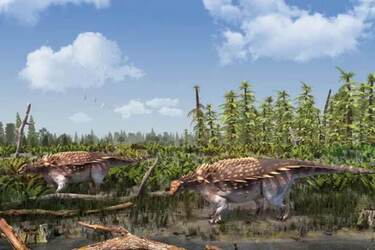Remains of a previously unknown dinosaur discovered on the Isle of Wight near Britain (photo)

The fossilized remains of a hitherto unknown species of armored dinosaurs have been discovered on the Isle of Wight in the English Channel is an important discovery. The last remains of such a large lizard on the island were found in 1865. The new species discovered this time belongs to the family of ankylosaurs, which have an armored shell and spiked body parts such as the neck, shoulders, and tail.
An article about the discovery was published in the Journal of Systematic Palaeontology that details the discovery of the new dinosaur species.
Read also: Scientists dispel the myth of low IQ of dinosaurs
Although the appearance of the dinosaur shows its terrifying appearance with armor and spikes, these structures actually served for self-defense against predators, as this species was herbivorous and did not attack other animals.
The fossil find belongs to a layer of soil that is 66 to 145 million years old. The species was named Vectipelta barretti in honor of Professor Paul Barrett, who works at the Natural History Museum in London.
Professor Barrett expressed his appreciation for the honor and thanked for the opportunity to present himself to the world in this way, smiling that any resemblance to a dinosaur is accidental.
Scientists compared the new species with other known ankylosaurus, including Polacanthus foxii, which were previously found on the island. Differences in the structure of the spine and pelvic bones, as well as a greater number of spikes in the new species were found.
It is also noted that the greater similarity of the new species to ankylosaurus found in China suggests that these animals may have moved between Europe and Asia in the early Cretaceous period.
Stuart Pond, a researcher at the Natural History Museum in London, expressed his belief that this discovery will help to revise other similar finds and contribute to the understanding of the diversity of dinosaurs that lived in England.
The team of archaeologists involved in the excavation believes that the site is of great importance for understanding the causes of dinosaur extinction. There are several theories about the massive death of these giant reptiles, including the Earth's collision with an asteroid and a supervolcano eruption.
As a reminder, 4000-year-old sarcophagi with legs were found in India.
If you want to get the latest news about the war and events in Ukraine, subscribe to our Telegram channel!
